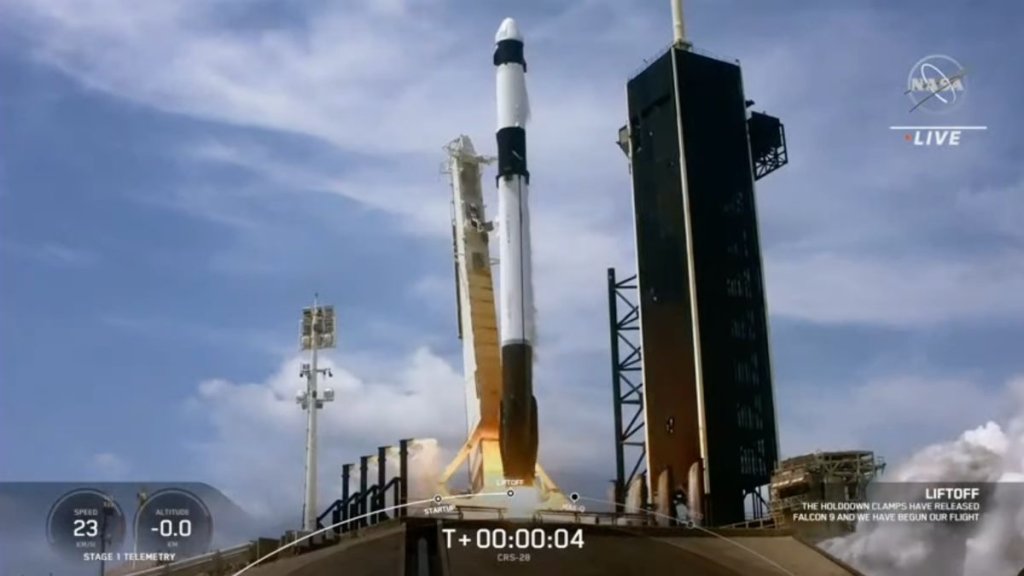
SpaceX launches Dragon cargo capsule to space station, lands rocket at sea (video) (Image Credit: Space.com)
SpaceX launched its 28th cargo mission to the International Space Station for NASA on Monday (June 5) after a two-day weather delay.
A SpaceX Falcon 9 rocket launched a robotic Dragon cargo capsule toward the orbiting lab on Monday at 11:47 a.m. EDT (1547 GMT) from NASA’s Kennedy Space Center in Florida.
Nine minutes later, the Falcon 9’s first stage came back to Earth for a pinpoint touchdown on the SpaceX droneship A Shortfall of Gravitas, which was stationed off the Florida coast. It was the fifth liftoff and landing for this particular booster, SpaceX said in a mission description.
Related: 8 ways that SpaceX has transformed spaceflight

The Falcon 9 upper stage deployed the uncrewed Dragon capsule in low Earth orbit as planned about 12 minutes after liftoff.
The spacecraft will now make an 18-hour trek to the International Space Station (ISS), with docking scheduled for Tuesday (June 6) at 5:50 a.m. EDT (0950 GMT). You can watch that rendezvous here at Space.com when the time comes.
Dragon is carrying about 7,000 pounds (3,175 kilograms) of science investigation supplies and provisions for the station’s crew. A delayed launch of Northrop Grumman’s Cygnus ISS resupply vehicle, NG-19, prompted NASA to transfer some of that mission’s intended cargo to Dragon in order to keep the space station’s cache from diminishing too much.
During a prelaunch press briefing on Tuesday (May 30), NASA’s ISS chief scientist Kirt Costello said that CRS-28 is “making up for the delays we had in our NG Cygnus vehicle arriving at Station. So, we’re sending up lots of extra logistics crew supplies for the crew to keep them going throughout the end of the year.”
The scientific research aboard CRS-28 brings new experiments to the ISS, as well as replenishing materials for over 30 ongoing projects. The CLINGER technology demonstration for autonomous space station docking systems, microgravity-induced DNA mutation of telomeres and blue energy thunderstorm discharge research are among some of the new science experiments going up on this mission.
Half a dozen cubesats are tucked away onboard the CRS-28 Dragon as well, all but one of which are student-run projects from the Canadian Space Agency’s Canadian Cubesat program. The sixth comes from the Aerospace Corporation, in partnership with the Air Force Research Laboratory and Space Systems Command. It’s called Moonlighter, and it will provide the platform for a space-based cybersecurity hacking challenge.
CRS-28 also carries the next pair of iROSAs (International Space Station Roll Out Solar Arrays), which are being attached above the ISS’ existing solar panels in order to augment station electricity needs. Those will be removed from Dragon’s trunk using the station’s robotic arm, then installed by NASA astronauts over the course of two spacewalks. Once operational, the full complement of iROSAs will boost the orbiting lab’s power supply by 20% to 30%.
SpaceX’s cargo Dragon is designed as a reusable vehicle, and will return scientific samples from over 34 investigations aboard the ISS at the end of its stay at the station. Like its crewed counterpart, the cargo Dragon comes back to Earth for soft, parachute-aided ocean splashdowns.
Today’s launch was originally scheduled for Saturday (June 3), but SpaceX announced a 24-hour delay before launch, citing the need to “allow more time for vehicle preparations and for weather conditions to improve,” according to a Twitter update. On Sunday (June 4), SpaceX announced another one-day delay, citing strong winds in the rocket recovery zone.
Editor’s note: This story was updated at 12:15 p.m. EDT on June 5 with news of launch, rocket landing and spacecraft deployment.








